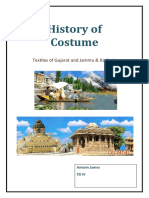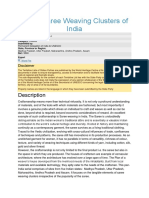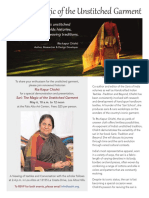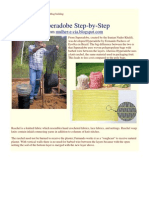IJCRT2305161
IJCRT2305161
Uploaded by
kunal vardhanCopyright:
Available Formats
IJCRT2305161
IJCRT2305161
Uploaded by
kunal vardhanOriginal Description:
Copyright
Available Formats
Share this document
Did you find this document useful?
Is this content inappropriate?
Copyright:
Available Formats
IJCRT2305161
IJCRT2305161
Uploaded by
kunal vardhanCopyright:
Available Formats
www.ijcrt.
org © 2023 IJCRT | Volume 11, Issue 5 May 2023 | ISSN: 2320-2882
A Review on journey of Sujani : handicraft
Ragini Tripathi, Dr. Ekta Sharma, Dr. Nargis Fatima
Research Scholar, Associate Professor, Assistant Professor
Department of Textile and Apparel Designing, SHUATAS, Prayagraj, UP 211007
Abstract
The study was undertaken to review the traditional art of Bihar, termed as Sujani. Traditional designs have endless
possibilities of inspiring countless innovations through re-interpretations, re-translations and adaptations. With this
is mind, an attempt has been made to study the designs with contemporary style inspired from the an age old craft
of Bihar region commonly known as Sujani of Bihar province of Union of India. Sujani mainly depicts stories and
in the past has been used extensively to spread awareness about social issues and empowerment of downtrodden
women. The crafts with Motifs, textile ornamentation presented on the traditional samples are considered heritage
to the communities that adopted them. The samples were then embroidered using the designs that had thus been
made. A detailed study on the potential consumers, acceptability of the designs in market and popularity of
techniques was carried out and presented in the paper.
Keywords: Sujani Handicrafts, , Growth of Sujani embroidery
Introduction
Indian handicrafts
Indian handicrafts is an art of making crafts by hand in India and commonly called Indian handicrafts. In
ancient India, people lived in colonies and termed as tribals and were used to make utility items for their daily
need. The art of making the crafts was called handicrafts, and the items called handicrafts goods. The people
started selling these products in the local markets “Haat”. With passage of time, people become more developed
and civilised, and thus demand for handicraft products have started to increase and so the trading of handicrafts.
India's Bihar province has a long and illustrious history. It was always the focus of historians' attention, from
ancient times to the present. In the rich land of Bihar, mighty dynasties like the Magadha Majanapadas, Mauryan
Empire, and Gupta Empire had flourished. Some great names of Indian history like Ashok, Chandragupta Maurya
and the symbol of peace and non-violence Gautam Buddha had their root in Bihar. Some of the great religions of
the world like Buddhism and Jainism had sprouted from here. Thus naturally Bihar has rich and varied arts and
IJCRT2305161 International Journal of Creative Research Thoughts (IJCRT) www.ijcrt.org b247
www.ijcrt.org © 2023 IJCRT | Volume 11, Issue 5 May 2023 | ISSN: 2320-2882
crafts. Throughout the generation, the rich heritage of art and crafts of Bihar has been preserved, though there are
slight variations due to introduction of modern technologies.
Kashida work of Bihar In contrast to Kashida of Kashmir, needlework from Bihar is known as Kashida of Bihar
and is more commonly done on everyday clothing such as saris, blouses, hats, sashes, wraps, and odhanis as well
as household textiles like pillow cases and quilts. However, males and women work as Kashida in Bihar and
Kashmir, respectively.
Bihar's embroidery is produced in a variety of forms, with appliqué art being particularly popular. On their own
clothing for personal use and occasionally for commercial purposes, they create this appliqué art. Since the former
is intended for oneself, it contains imaginative themes that are either abstract or extremely stylized.
Khatwa, or appliqué work The appliqué and patchwork of Bihar is known locally as Khatwa and is frequently
seen on wall hangings, shamianas, or festively decorated tents and canopies, as well as saris, dupattas, cushion
covers, tablecloths, and curtains.
The craft is typically done with white cloth on vivid backdrops like red or orange and employs leftover bits of
cloth as its raw material. The craftsmanship was so excellent that in the past, aristocracy, kings, and emperors used
the items made. Human people, trees, flowers, animals, and birds are among the motifs.
Kantha embroidery Pre-Vedic needlework gave rise to kantha. Kantha embroidery was done specifically using
the quilt. Quilts were created using two different types of embroidery. Old and unwanted cotton saree quilts from
the first category are heaped on top of one another. In the second form, the top and bottom were covered in cotton
or cloth, or a shell was created, and needlework was then applied. Silk thread can be used in embroidery to
increase durability. Between the sarees in this, sometimes old clothing was also worn.
This art was the art of Bengali women. In which Bengali women irrespective of caste, whatever class, whatever
social economic background features in. Embroidery refers not only to the stitch employed rather it is the
individual’s creative, also reflects her imagination and craftsmanship. Kantha size and thickness its types
according to or as required.
Kasuti work ‘Kasuti’ is a world famous embroidery of Karnataka state earlier was known as Mysore state, the
motifs and art is a part of women’s world. Kasuti embroidery speaks about the people of Karnataka their traditions,
customs and profession. This is an outcome of the honest, zealous and innate desire of ‘mankind’ to practice the
beautiful stitches on the articles of every day use. The urge of learning Kasuti was common to both royals,
aristocrats and peasand women.
Kashida work The word Kashmir can be splitted as ‘Kas’ means ‘water channel’ and ‘mir’ refers to ‘mountain’
,however literally Kashmir means ‘rock through’ in the regional language. The best Known of India, Jammu and
Kashmir is known for its beauty. The locality is embedded with enchanting beautiful and inexhaustible flora and
fauna, transquil lakes, garden of perpetual spring, abundance of natural colour all around, which has inspired many
writers, poets, artists and creative craftmen.
IJCRT2305161 International Journal of Creative Research Thoughts (IJCRT) www.ijcrt.org b248
www.ijcrt.org © 2023 IJCRT | Volume 11, Issue 5 May 2023 | ISSN: 2320-2882
Kashida, embroidery is quite popular due to its colour, texture, design, and technique. The very embroidery
is in turn revealed in shawls as well as in cottage industry performed by every member of families of Srinagar.
Kashmir embroidery is particularly practiced by men of the families and is a total commercial craft.
Sujani Embroidery is a heritage of India. Sujani embroidery is done in Bhusara village of Bihar district. In ancient
times, it was considered a form of quilt, the old cloth used as a creative canvas.
The cloth was folded three to four times. And then fine stitches are applied to add newness to these used
clothes in which running stitch was used. The Sujani of Bihar is remarkably similar to the Kanthas of Bengal.
Initially Sujani was made for traditional purposes. At the time of child birth, patches of different coloured cloth
from old saris were sewn together with a simple running stitch to make a quilt called Sujani.
The Geographical Indications of Products (Registration & Protection) Act (GI Act) of 1999 of the Government
of India protects the Sujani embroidered work of Bihar. It was listed as Sujani Embroidered Work of Bihar under
GI Application number 74, Class 26 as a textile article, and registered by the Controller General of Patents,
Designs, and Trademarks. GI tags were authorised on September 21, 2006.
Historical Background
The 18th century marks the beginning of the embroidery Sujani quilt's traditional production. Its main objective
was to provide newborn babies with a cosy blanket as soon as possible after birth. A basic running thread was used
to weave pieces of cloth in various colours from old saris and dhotis together to create the final product. With this
method, three or four old sari or dhoti patches were used, put one over the other, and then quilted together using
thread also taken from the abandoned clothing.
Sujani is a centuries-old tradition among Biharian women, and what sets it apart is the distinctive story
components embroidered on it. On the Sujani, women sew their experience, their grief, and their truths, turning a
plain quilt into a testament to their life. Old Sujanis contained symbols from daily life, nature, and religion. Hindu
epics are depicted in detail in the artwork, as with social issues such female infanticide, election violence, girls'
education, and domestic abuse situations. Lectures about health care, environmental parables, and pictures of
women fighting for their rights all have a tremendously empowering effect. This is both incredibly intriguing and
enlightening because it originates from Bihar, a state with a high prevalence of female infanticide and dowry cases.
Theme of motif
Women sew their experiences, grief, and realities onto a Sujani depicting their lives.
Each Sujani offers a story on a related topic, such as domestic abuse, female infanticide, the effects of
drunkenness and gambling on a family, etc.
Societal issues like dowry's negative effects, girls' education, health care's problems, and AIDS are also
shown.
IJCRT2305161 International Journal of Creative Research Thoughts (IJCRT) www.ijcrt.org b249
www.ijcrt.org © 2023 IJCRT | Volume 11, Issue 5 May 2023 | ISSN: 2320-2882
Product information of Sujani Embroidery
The patchwork created with this embroidered work symbolises the agonising aspirations of women in a world
dominated by men. She creates the craft work by embroidering particular designs on both sides of the finished
item. The designs on one side of the fabric depict the women's distress at the violent behaviour of inebriated men
against their wives and the act of paying dowry.
Origin and background
India is a diverse nation, and women, both working and stay-at-home mothers, have traditionally specialised in
embroidery. Stitching still holds promise for every significant event in a woman's life, including weddings, births,
and religious celebrations. Sujani embroidery was created in the state of Bihar in this way.
Sujani is a combination of the terms "su," which means to facilitate, and "jani," which signifies birth. Sujani
embroidery was used to create motifs and designs on the quilts for newborn babies after colourful patches of used
clothing were sewn together.
Method & Technique used of Sujani embroidery
The most crucial requirement is to utilise a foundation cloth made of readily available basic materials. Using a
tracing wheel and tracing sheet, the pattern is first traced into the foundation fabric. The background is then started
to be drawn by fine running stitches. And finally, the designs are outlined with black or brown threads and
coloured threads are utilised to provide colour. A needle, frame, scissor, various coloured threads, inch tape,
tracing paper, tracing wheel, pencil, rubber, blue chalk, and kerosene are needed to complete the Sujani stitch.
Different Applications of Sujani embroidery
The artisans created stunning embroidered motifs of gods, flowers, and peacock designs for wall decoration using
delicate running stitch. When fashion changed, artisans began adding Sujani embroidery to sarees, kurtas,
dupattas, and other items of apparel that were traditionally worn in India. Among of the common things with
Sujani needlework includes wall hangings, bedspreads, and pillow covers for the home. The Tussar silk fabric is
used to make jackets and stoles for winter wear that feature Sujani embroidery.
Inspirational Sources
The Sujani embroidery technique, which entails sewing together layered scraps of old fabric, has its roots in
traditional ways of doing things. For instance, these discarded cloth scraps that had been put together were thought
to be the best choice for covering or quilting neonates. Moreover, another rite was meant to conjure a deity named
"Chitiriya Maa, who was honoured as the 'Lady of the Tatters'. From designs of holy animals and fertility symbols,
which were meant to invoke the benefits of the gods, to sun and cloud motifs, which represented the powers of
life. Even the colours had symbolic meanings, with red denoting vigour and yellow denoting the sun.
IJCRT2305161 International Journal of Creative Research Thoughts (IJCRT) www.ijcrt.org b250
www.ijcrt.org © 2023 IJCRT | Volume 11, Issue 5 May 2023 | ISSN: 2320-2882
Weakness of Sujani embroidery
• Sujani embroidery is a highly taxing task.
• Over time, artisans who practise Sujani lose or weaken their visual sight.
• Craftspeople frequently complain of headaches and backaches due to the complexity of the craft form.
• The work is time-consuming.
Situations and issues faced by artists
• A lack of literacy and basic infrastructure.
• A lack of funding for talent promotion and marketing.
• Electrical problems and a lack of a consistent source of income.
• Due to inconsistent employment and money, the majority of women give up. Employment only occurs
every two to three months, and the monthly income is usually only 200 to 500 rupees.
Sujani's SWOT analysis
Sujani embroidery is a type of handcraft that involves a lot of time and expertise to craft the needlework that is
made on many varieties of objects, letting the craftsmen make a living. Sujani embroidery is GI registered and is
considered a cultural heritage of India. Running stitch and chain stitches make up the two basic stitches.
Rebirth of Sujani
Sujani production is back Sujani production had all but vanished until ADITHI brought it back in 1988. It operates
through the Mahila Vikas Sahyog Samiti (MVSS), a tiny independent organisation with headquarters in the Bihar
district of Bhusura. Sujani needlework, formerly a tool for domestic recycling, is today a form of expressive art.
Now, this enterprise employs 600 women from 22 villages near Bhusura. The non-profit organisation MVSS was
founded in 1988. Its current name is Bhusra Mahila Vikas Samiti.
Sujani's expansion
• FINANCIAL MARKETING ASSISTANCE: Sky Morisan was the pioneer in promoting Sujani
embroidery in the export market. Also, the government and Charities support sujani embroidery on the
national market.
• LABOUR COST: Sujani's labour costs are extremely high due to the complexity of the work. The price per
square inch is 10 paisa. The labour cost for a bed sheet (60*90) is around Rs. 1500 (as of October 2004).
• Only a select few people may now purchase this craft in India, and it is primarily manufactured for the
export market.
IJCRT2305161 International Journal of Creative Research Thoughts (IJCRT) www.ijcrt.org b251
www.ijcrt.org © 2023 IJCRT | Volume 11, Issue 5 May 2023 | ISSN: 2320-2882
Conclusion
Due to its complexity, laboriousness, and time-consuming nature, sujani is costly in marketplaces. But, if we look
more closely at the various needlework techniques to make them more widely used commercially, we may assist
preserve the long-standing Bihar culture. As a result, the attempt to combine hand and machine embroidery in this
study can be examined since it produces a good blend of the traditional hand labour and expands the market by
using some automation.
REFERENCE
Brijbhushan, J., (1990), Embroidery of Bihar, Indian Embroidery ,Ministry of Information and
Broadcasting, New Delhi, 1st Edition pp-15
Naik D. Shailaja 1996, Traditional embroideries of India. A.P.H. Publishing Corporation 5, Ansari Road,
Darya Ganj, New Delhi 110002
Conway, S.,R. Barnes, and R.Crill, (1999),’Bihar Qualting and North-East Thai Weaving: A Comparative
Study of Status, Textile History
(2002) Indian Book House Pvt Ltd, Mumbai, 1Edition, pp-20.
Agrawal Y, (2003) Heritage Textiles, Silk Brocades, 1 Edition pp- 102.
M. & Roy, T. (2004) World bank report, ‘Handemade in India: traditiomal crafts skills in a changing
world’
Finn, P.J, (2014) ‘Sujani’, Quilts of India: Timeless Textiles, Niyogi Books, New Dellhi, 1st Editon, pp87-
89.
Adhikari Suchismita & Gupta Samita, (2017) International Journal of Textile and Fashion Technology
Jha Banhi, (2019) Sujani embroidery and community of practice in, pp-1-3
http://www.craftandartisans.com/sujani-kantha-embroidery-of-bihar.html
https://en.m.wikipedia.org/wiki/Sujani-embroidery-work-of-Bihar
https://en.wikipedia.org/wiki/Handicraft
https://biharfoundation.bihar.gov.in/UContantManger/ShowContant?contentpp=54
https://www.umsas.org/en/bihar-arts-crafts/sujani-embroidery
IJCRT2305161 International Journal of Creative Research Thoughts (IJCRT) www.ijcrt.org b252
You might also like
- Definitive Guide To White HairDocument24 pagesDefinitive Guide To White Hairmegan_pritchard9016No ratings yet
- 13 - Site-Specific ArtDocument31 pages13 - Site-Specific ArtEloiseNo ratings yet
- Wande Abimbola 1Document24 pagesWande Abimbola 1comipca67% (3)
- Traditional Indian Costumes and TextilesDocument11 pagesTraditional Indian Costumes and TextilesMariaMaraNo ratings yet
- Research Paper On Kashida and Baawan ButiDocument11 pagesResearch Paper On Kashida and Baawan ButiAkshita Wadhwana100% (2)
- An Attempt To Review The Sujuni Embroidery of Bihar: Akanksha PareekDocument2 pagesAn Attempt To Review The Sujuni Embroidery of Bihar: Akanksha Pareekaryasahu818No ratings yet
- Ancient Indian FashionDocument33 pagesAncient Indian Fashiontamara_anand3289100% (1)
- Crafts of GujaratDocument14 pagesCrafts of GujaratPankhuri AroraNo ratings yet
- Kutch EmbroideryDocument9 pagesKutch EmbroideryShachi Sheth50% (2)
- 06 Chapter1 PDFDocument10 pages06 Chapter1 PDFVarshaNo ratings yet
- Fashion Show IdayDocument30 pagesFashion Show Idayagga1111No ratings yet
- Tradition Mising Weaving CraftDocument4 pagesTradition Mising Weaving CraftLee DarciaNo ratings yet
- 14-03-2020-1584165185-8-Ijhss-4. Ijhss - Influence of Socio-Cultural Factors On Craft Skills of Pattu Weavers of Barmer, Rajasthan - ProofreadDocument9 pages14-03-2020-1584165185-8-Ijhss-4. Ijhss - Influence of Socio-Cultural Factors On Craft Skills of Pattu Weavers of Barmer, Rajasthan - Proofreadiaset123No ratings yet
- A Review Study On Banjara Embroidery of MaharashtraDocument6 pagesA Review Study On Banjara Embroidery of Maharashtrareenaagarwal2008No ratings yet
- Ways To Revive Crafts of BiharDocument13 pagesWays To Revive Crafts of BiharNupur KamalNo ratings yet
- History of Costume: Textiles of Gujarat and Jammu & KashmirDocument13 pagesHistory of Costume: Textiles of Gujarat and Jammu & KashmirAntwin JamesNo ratings yet
- A Management Approach To Sambalpuri Sari With A Sign of Cultural FacetsDocument7 pagesA Management Approach To Sambalpuri Sari With A Sign of Cultural Facetsniku007No ratings yet
- Ijtk 9 (4) 651-655Document5 pagesIjtk 9 (4) 651-655manash85No ratings yet
- KANTHADocument19 pagesKANTHAaaryaNo ratings yet
- Nakshi KanthaDocument4 pagesNakshi KanthaIsaba MasnunNo ratings yet
- Women 21Document102 pagesWomen 21Raghu VermaNo ratings yet
- Shukla-Evaluating SarisDocument17 pagesShukla-Evaluating Sarisccfnwd4wm9No ratings yet
- Iconic Saree Weaving Clusters of India: DescriptionDocument4 pagesIconic Saree Weaving Clusters of India: Descriptionrahul sagarNo ratings yet
- Iconic Saree Weaving Clusters of IndiaDocument4 pagesIconic Saree Weaving Clusters of Indiassingh100% (1)
- Centre of Fashion Design and Technology Institute of Professional Studies University of Allahabad PrayagrajDocument41 pagesCentre of Fashion Design and Technology Institute of Professional Studies University of Allahabad PrayagrajAshtha SinghNo ratings yet
- Ikat - Sambhalpuri and Bomkai WeaveDocument14 pagesIkat - Sambhalpuri and Bomkai WeaveAmarendra AgrawallaNo ratings yet
- Bangladesh Studies PresentationDocument9 pagesBangladesh Studies PresentationRębelliØus HritiNo ratings yet
- UNNATI CHAURASIA TD SEM 3Document25 pagesUNNATI CHAURASIA TD SEM 3Unnati ChaurasiaNo ratings yet
- Textiles and Traditional WearsDocument23 pagesTextiles and Traditional WearsDeepshikha JaiswalNo ratings yet
- Sachi SariSpeaker 032017r3 WebDocument2 pagesSachi SariSpeaker 032017r3 WebDipayan RaychowdhuryNo ratings yet
- An Introduction to Traditional Hand Embroideries of IndiaFrom EverandAn Introduction to Traditional Hand Embroideries of IndiaNo ratings yet
- Pochampally IkatDocument23 pagesPochampally Ikatagga11110% (1)
- Text Tribal Embroidery of IndiaDocument7 pagesText Tribal Embroidery of Indiamansiagrawal100% (1)
- Sabyasachi MukherjeeDocument19 pagesSabyasachi MukherjeePurva Agrawal100% (3)
- YOJANA May 2024sDocument15 pagesYOJANA May 2024smyonline WorksNo ratings yet
- Embroideries of Gujarat: Presented By: Krishnanjali Chandan Ragini SurbhiDocument49 pagesEmbroideries of Gujarat: Presented By: Krishnanjali Chandan Ragini Surbhisurbhimo83% (12)
- Kantha Embroidery Is A Traditional Form of Embroidery That Originated in The Indian SubcontinentDocument2 pagesKantha Embroidery Is A Traditional Form of Embroidery That Originated in The Indian SubcontinentShantav GargNo ratings yet
- HnloomDocument7 pagesHnloomAnonymous OHmhYtUjyTNo ratings yet
- Traditional Indian Costumes and Textiles: January 2004Document11 pagesTraditional Indian Costumes and Textiles: January 2004Vijay ZorroNo ratings yet
- The Tale of The Sari in India and BeyondfpkrtDocument3 pagesThe Tale of The Sari in India and Beyondfpkrtbodybronze07No ratings yet
- Craft ResearchDocument41 pagesCraft ResearchJyoti KhatriNo ratings yet
- WorkDocument12 pagesWorklkgsomuNo ratings yet
- Anakaputhur Weaver's AssociationDocument62 pagesAnakaputhur Weaver's AssociationExigencyfor Words100% (1)
- Research On Traditional Sari Draping Method and Its Aesthetic EvaluationDocument18 pagesResearch On Traditional Sari Draping Method and Its Aesthetic EvaluationVP EnterpriseNo ratings yet
- Textiles of IndiaDocument26 pagesTextiles of IndiahhNo ratings yet
- Hat - Making ProcessDocument10 pagesHat - Making ProcessSingh ManpreetNo ratings yet
- Traditional Textiles of IndiaDocument46 pagesTraditional Textiles of IndiaChetna Shetty Dikkar50% (2)
- Index 1. Chikankari 2. Toda 3. Kasuti 4. KanthaDocument13 pagesIndex 1. Chikankari 2. Toda 3. Kasuti 4. Kanthapawan TNo ratings yet
- SFDA1301Document99 pagesSFDA1301Sanskriti PatidarNo ratings yet
- Al Sadu WeavingDocument10 pagesAl Sadu WeavingsambagaNo ratings yet
- Textile of India - KarnatakaDocument9 pagesTextile of India - KarnatakaPhulkari PunjabNo ratings yet
- Project by R. Priyadharsini B.SC (FD)Document10 pagesProject by R. Priyadharsini B.SC (FD)PRIYADHARSININo ratings yet
- Market Statistics Report11Document9 pagesMarket Statistics Report11Pooja PatelNo ratings yet
- History of Indian EmbroideryDocument2 pagesHistory of Indian EmbroiderySaransh Rastogi100% (1)
- On The Great Indian Handloom Traditions - Cultural Samvaad Indian Culture and HeritageDocument1 pageOn The Great Indian Handloom Traditions - Cultural Samvaad Indian Culture and Heritagehadassahbethapudi4No ratings yet
- Engineered Ikat Textile of Gujarat - A Design Intervention: Digitalcommons@University of Nebraska - LincolnDocument11 pagesEngineered Ikat Textile of Gujarat - A Design Intervention: Digitalcommons@University of Nebraska - LincolnSimoni KhetaniNo ratings yet
- Handloom in IndiaDocument7 pagesHandloom in IndiaAnkita SinhaNo ratings yet
- KASUTI pptDocument28 pagesKASUTI pptkritishri2004No ratings yet
- Index 1. Chikankari 2. Toda 3. Kasuti 4. Kantha 5. RabariDocument14 pagesIndex 1. Chikankari 2. Toda 3. Kasuti 4. Kantha 5. Rabaripawan TNo ratings yet
- KhadiDocument9 pagesKhadirutuja hajareNo ratings yet
- Pottery Entrepreneurship An Age Old GlorDocument8 pagesPottery Entrepreneurship An Age Old Glorbloomingflowers9635No ratings yet
- Filipino ChemistDocument11 pagesFilipino ChemistJannet De Lara VergeldeDiosNo ratings yet
- Set-2013 How To ApplyDocument4 pagesSet-2013 How To Applysubhas9804009247No ratings yet
- apcolite-advanced-shyne - CopyDocument2 pagesapcolite-advanced-shyne - CopyAyush NigamNo ratings yet
- Pressure Vessel Inspection ReportDocument34 pagesPressure Vessel Inspection ReportJinlong SuNo ratings yet
- Mechanix Illustrated How To Do It Encyclopedia Vol 6Document200 pagesMechanix Illustrated How To Do It Encyclopedia Vol 6freeneasyguy100% (3)
- CR Laurence Glass Railing CatalogDocument468 pagesCR Laurence Glass Railing CatalogMike67% (3)
- Deconstruction and Graphic Design History Meets Theory PDFDocument12 pagesDeconstruction and Graphic Design History Meets Theory PDFAlfonso LabrencioNo ratings yet
- Fernando Amorsolo Fernando Amorsolo Was Born On May 30, 1892 in Calle Herran in Paco, ManilaDocument5 pagesFernando Amorsolo Fernando Amorsolo Was Born On May 30, 1892 in Calle Herran in Paco, ManilaGerald Reyes LeeNo ratings yet
- Yr34 Art Term 1Document4 pagesYr34 Art Term 1api-485205773No ratings yet
- LearnToDraw PDFDocument79 pagesLearnToDraw PDFSiva RudraNo ratings yet
- History - of - Photography - Lecture 1Document35 pagesHistory - of - Photography - Lecture 1Amna KhanNo ratings yet
- Tema 2 (Geografía UK)Document35 pagesTema 2 (Geografía UK)Francisco Javier FerreNo ratings yet
- Your Home Made New.: Decorative Painting TechniquesDocument20 pagesYour Home Made New.: Decorative Painting TechniquesTina RalucaNo ratings yet
- Cmci Cmci: CEMTEC 227 P.SDocument2 pagesCmci Cmci: CEMTEC 227 P.Spravi3434No ratings yet
- Radonjin EsejDocument7 pagesRadonjin EsejNatasa PrelevicNo ratings yet
- John Jufel VDocument4 pagesJohn Jufel VJohn Jufel ValdezNo ratings yet
- About Contemporary ArtDocument2 pagesAbout Contemporary ArtSheila May BautistaNo ratings yet
- Sotheby's Sale of Fine Watches To Feature Limited-Edition Watch by George DanielsDocument3 pagesSotheby's Sale of Fine Watches To Feature Limited-Edition Watch by George DanielsGavelNo ratings yet
- Fresh Kills ParkDocument18 pagesFresh Kills Parkheya16No ratings yet
- Hyperadobe (Passo A Passo)Document15 pagesHyperadobe (Passo A Passo)Vander De Almeida Candido50% (2)
- Barcelona A Photographic Tour, Sample ChapterDocument29 pagesBarcelona A Photographic Tour, Sample ChapterAlexandru CiobanuNo ratings yet
- Renaissance (Italy and France)Document91 pagesRenaissance (Italy and France)Chicha WatersNo ratings yet
- Understanding EscherDocument17 pagesUnderstanding EscherDoug WhittierNo ratings yet
- Renaissance Image of The Man and The World - B. O'KelleyDocument224 pagesRenaissance Image of The Man and The World - B. O'KelleyHula La100% (4)
- Frida - DIVERSOSDocument12 pagesFrida - DIVERSOSGabriela CapaNo ratings yet
- CV and Portfolio PDFDocument20 pagesCV and Portfolio PDFjonnizzNo ratings yet
- Nankov MechDocument10 pagesNankov MechEmilNo ratings yet

























































































